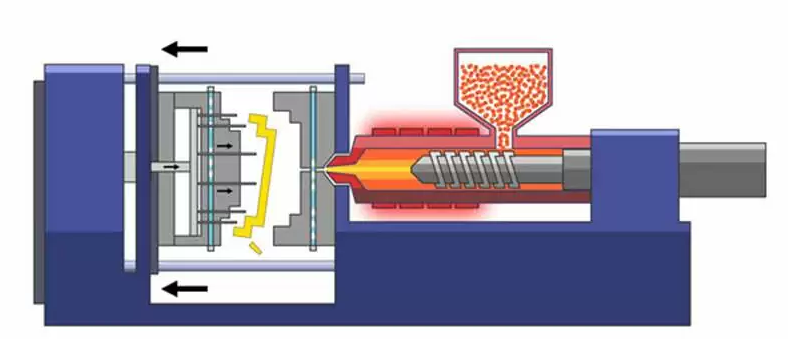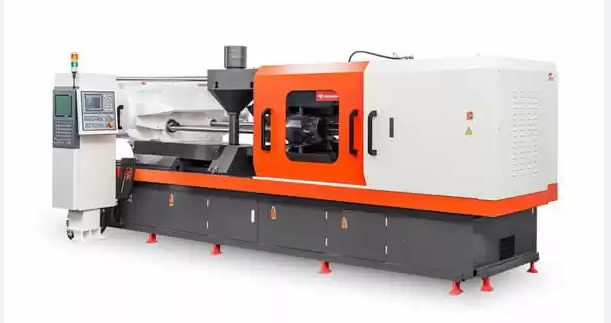To determine the right size injection molding machine, calculate the product’s projected shot volume, material type, and cycle time.
Understanding Injection Molding Machine Size
Key Components of Injection Molding Machines
Injection molding machines comprise several essential components that actively determine their functionality and suitability for various tasks. The clamping unit plays a crucial role in opening and closing the mold and maintaining the necessary pressure. Clamping force, a vital specification, ranges widely from 5 to 6,000 tons and determines the size of the part that the machine can mold. The injection unit melts and injects the material into the mold, and its size influences the shot size – the maximum volume of material that the machine can inject in one cycle. Consequently, parts requiring more material necessitate machines with larger injection units.

The controller is another pivotal component that manages machine operations and ensures precise control, particularly important for complex or high-precision parts. Modern injection molding machines boast advanced controllers with touchscreen interfaces and real-time monitoring capabilities, enhancing operational accuracy and efficiency.
Metrics for Sizing Injection Molding Machines
Choosing the right size for an injection molding machine involves a thorough understanding of several key metrics:
Clamping Force: This metric is directly related to the size of the part. Larger parts require machines with higher clamping force to effectively hold the mold closed against the high pressure of the injected material. For example, manufacturing automotive parts like bumpers typically demands a clamping force of over 2,000 tons.
Shot Size: This metric indicates the maximum volume of plastic that the machine can inject in a single cycle. It’s imperative to select a machine with a shot size that comfortably exceeds the volume of the part to be molded. For instance, a part with a volume of 150 cubic centimeters would ideally require a machine with a shot size of at least 200 cubic centimeters to ensure complete filling of the mold.
Platen Size: The size of the machine’s platens must be large enough to accommodate the mold. A larger mold demands larger platens, which, in turn, influences the overall size of the machine.
Tie Bar Spacing: This metric reflects the distance between the tie bars that hold the mold. The machine cannot mold parts larger than this spacing.
Energy Consumption: Larger machines typically consume more power. For example, a machine with a clamping force of 300 tons might consume about 25 kW, while a machine with a 2,000-ton capacity could consume 180 kW or more.
For more detailed insights, one can refer to the comprehensive Injection Molding Machine article on Wikipedia.
Determining the Required Clamping Force
Calculating Clamping Force for Your Parts
Calculating the clamping force for injection molding parts is a critical step in ensuring quality and efficiency. The basic formula for clamping force calculation is: Clamping Force = Projected Area x Injection Pressure. The projected area is the surface area of the part in the direction of the applied force, measured in square inches. The injection pressure, typically ranging from 1,500 to 20,000 psi, depends on the material used and the part design.
For instance, if a part has a projected area of 10 square inches and the material requires an injection pressure of 15,000 psi, the required clamping force is 150,000 pounds (10 x 15,000). It’s crucial to note that this is a simplified calculation and real-world scenarios may require adjustments for factors like the number of cavities in the mold.
Factors Influencing Clamping Force Requirements
Several factors play a significant role in determining the necessary clamping force for a given part:
Part Size and Geometry: Larger parts with greater surface areas require more clamping force. Complex geometries might necessitate higher forces to counteract the uneven distribution of material and pressure.
Material Characteristics: Different materials have varying flow properties and viscosities. Materials that are more viscous require higher injection pressures, thus increasing the clamping force needed.
Mold Design: The number of cavities in a mold and their layout can affect the overall force required. A mold with multiple cavities might require a higher clamping force to ensure uniform filling and pressure distribution.
Process Parameters: Factors such as injection speed and temperature also influence the required clamping force. Faster injection speeds and higher temperatures can reduce viscosity, potentially lowering the needed force.
Balancing the clamping force with the part design and material characteristics is essential to optimize the injection molding process. Overestimating the force can lead to excessive energy consumption and increased wear on the machine, while underestimating can cause defects in the parts.
For an in-depth understanding of clamping force and its calculations, refer to the Injection Molding Pressure section on Wikipedia.
Shot Size and Injection Volume Considerations
Estimating the Necessary Shot Size
When determining the necessary shot size for an injection molding process, it’s crucial to accurately measure the volume of the part along with the runner system and sprue. The shot size should exceed the total volume, typically by 10-20%, to ensure complete filling and compensate for material shrinkage. For instance, if a part’s volume is 100 cubic centimeters, considering runners and sprue, the total volume might reach 120 cubic centimeters. Therefore, a machine with a shot size of at least 144 cubic centimeters (120 cc plus 20%) is ideal.
It’s also important to consider the machine’s efficiency. Machines operating close to their maximum shot capacity can experience wear and decreased efficiency. Ideally, selecting a machine that operates at 50-80% of its maximum shot capacity ensures longevity and consistent performance.

Material selection has a significant impact on the required shot size. Different materials have varying densities, which affects the volume of material needed. For example, a part that weighs 100 grams using a material with a density of 1.04 g/cm³ will have a volume of approximately 96.15 cubic centimeters. If another material with a density of 0.90 g/cm³ is used, the volume increases to around 111.11 cubic centimeters.
Moreover, the material’s flow properties influence the shot size. Materials with higher flowability may fill the mold more easily, potentially allowing for a smaller shot size. Conversely, more viscous materials might require a larger shot size to ensure complete mold filling without short shots.
Balancing material properties with the part’s volume is essential for determining the optimal shot size. This balance ensures efficient use of material and energy, as well as high-quality part production.
For more comprehensive information on shot size and material considerations in injection molding, the Injection Molding Material Selection guide on Wikipedia offers valuable insights.
Machine Specifications and Part Design
Analyzing Part Design to Choose Machine Size
| Factor | Description | Impact on Machine Selection |
|---|---|---|
| Part Size | The physical dimensions of the part being molded. | Determines the clamping force required. Larger parts require machines with higher clamping force. |
| Part Complexity | Includes details like undercuts, thin walls, and intricate geometries. | Complex parts might need advanced machines with higher precision and control. |
| Material Used | Different materials have varying properties affecting moldability. | Influences the selection of the machine’s injection unit, as some materials require higher injection pressures. |
The Impact of Mold Size on Machine Selection
| Factor | Description | Impact on Machine Selection |
|---|---|---|
| Mold Dimensions | The size of the mold used for creating the part. | Requires machines with adequate platen size and tie-bar spacing to accommodate the mold. |
| Mold Weight | Heavier molds necessitate stronger clamping mechanisms. | Machines with higher clamping force can handle heavier molds more effectively. |
| Cavity Count | Number of parts produced in one cycle. | Multi-cavity molds may need machines with larger shot sizes and more precise injection control. |
Choosing the right machine involves a careful analysis of both the part design and the mold requirements. Understanding these factors is crucial to ensure efficient production and high-quality parts. Additionally, the selection heavily influences the overall production cost and energy efficiency. For example, a machine that is too large for the part being produced can lead to unnecessary energy consumption and increased operational costs.
For a detailed understanding of machine specifications in relation to part and mold design, the Injection Molding Machine Specifications section on Wikipedia provides comprehensive information.




